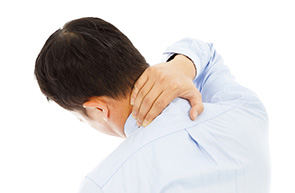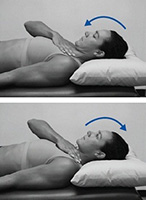
Whiplash for many can occur when involved in a car accident or by any number of knocks, falls or slips and sports injuries, and can be excruciatingly painful. Many people are shocked to realise that even mild cases of whiplash can happen just by simply turning your head too fast in one direction, being knocked down, falling or even being jostled around while riding a roller coaster or other type of fast moving ride.
In a rear end collision the neck is thrown into extension. What this means is that the person is forced backwards into the car seat as the vehicle is thrust forward. This force is what causes the most damage to the soft tissue area of the neck.
After the head comes into contact with the head restraint of the car it rebounds forward forcing the neck into flexion. As the seatbelt tightens the head is inadvertently thrown forward until the chin hits the chest.
When this movement occurs many things happen in the body at once.
- The muscles and ligaments that support the spine can be stretched or torn
- The discs can bulge, tear or rupture if the damage is severe enough
- Vertebrae can lose their normal range of motion
- The spinal cord and nerve roots can become stretched and irritated.
This action of the head can lead to debilitating pain, including neck stiffness, headaches, blurred vision, nausea, vertigo or numbness and tingling. Symptoms in acute whiplash may not appear at their peak until after the body has coped with the shock of the accident, and pain sets in.
You should be examined as soon as possible after a whiplash accident, even if the symptoms do not seem too severe. This is because it can take days or weeks for symptoms to properly develop. Identifying and addressing problems early will limit pain and recovery time.
Chiropractors commonly employ different chiropractic treatments for whiplash, often including:
- Soft tissue techniques can be done through the use of dry needling, muscle stimulation, and soft tissue massage.
- Muscle strengthening and neurological rehabilitation, our aim is to recondition the musculature and neurological system of the neck in order to reduce the level of discomfort.
- Gentle spinal manipulation. These manipulations, also known as adjustments, are characterised by specific thrusts on different areas of the vertebrae in order to provide proper alignment. These adjustments can provide the patient with more neck function and restore their normal movement.
- Ergonomic and lifestyle changes.
Each whiplash case is different. A chiropractor will evaluate the patient and determine the appropriate treatment on a case by case basis.
Stretch of the Month
The Chin Nod Stretch

- Lie down with a soft pillow under your neck, and with your knees bent up.
- Gently and slowly nod your head forward as if to say ‘yes’.
- Feel the muscles at the front of your neck.
- Stop the nodding action just before you feel the front muscles hardening.
- Hold the nod position for five seconds and then relax.
- Gently move your head back to the normal start position
- Repeat up to 10 times.
Towards Wellness
Add Spinach to Your Diet
Aside from being rich in vitamin C, which is the number one vitamin that boosts immune function, Spinach is also packed with antioxidants and beta carotene that are significant in the infection-fighting capability of our immune system.
You may add spinach to your smoothie ingredients or just lightly cook it when use in other dishes to retain its nutrients.

